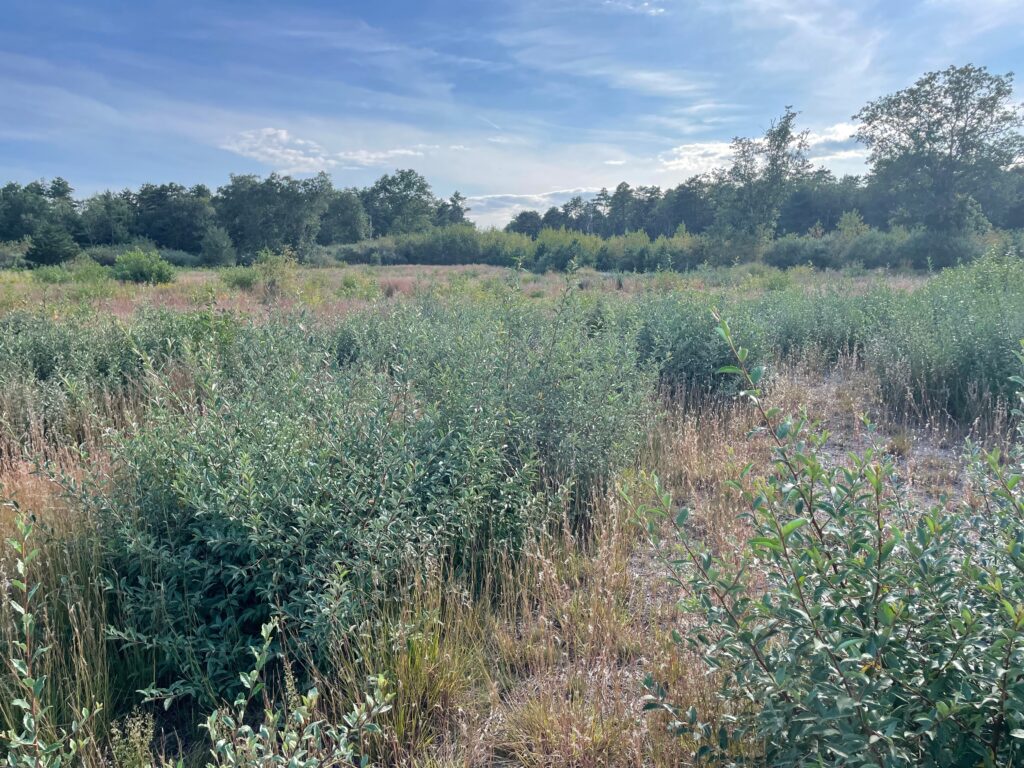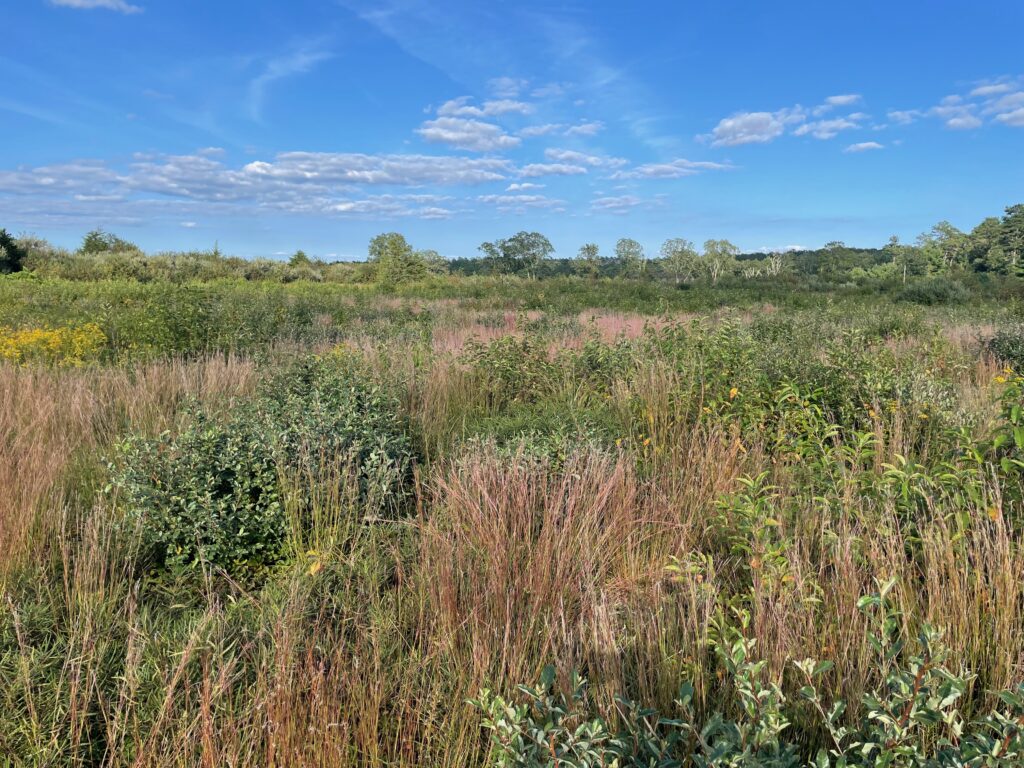Rhode Island’s Nuclear Fatality
I had a friend come give a talk at URI a couple of weeks ago, who works on the nuclear West. An art professor was there and asked if we had visited the site of Rhode Island’s nuclear fatality. I had never even heard of this. He was excited that someone would care about this and so he gave me a bunch of information about it. So we went and visited the site. First, the information.
But this week had been a nightmare. On Wednesday, Peabody had been washing equipment on the second floor when a radiation alarm sounded. He and the four others who worked with him on the four-to-midnight shift ran from the building. When none of the several other alarms in the plant went off, and when measuring devices detected no radioactivity, they returned to the building. Water had splashed on the alarm’s electrical contacts, shorting them. Still, it had been quite a scare.
That had been the day, too, when the black goo began appearing near the end of the processing line. It seemed to be some sort of organic compound, but nobody knew quite what it was or where it was coming from. The plant was made up of a series of tanks, long, columnar tubes where materials could be viewed and separated, and evaporating beds, all connected by pipes. When everything was running as it should, the place operated like a factory, with material moving from step to step, growing purer with each new procedure, waste materials drained off at several points along the way. At the end of the line would emerge uranium “rust,” which could be made into nuclear fuel.
Black goo is always a good sign at the nuke facility.
The black goo was not part of the plan. By the start of Thursday’s overnight shift, the problem had gotten so bad that some equipment had to be shut down and disassembled for cleaning.
The result was a motley collection of containers, each holding an item or substance that was to some degree radioactive. The covered buckets containing rags and low-level waste were of no particular concern. But there were identical plastic bottles, some filled with highly concentrated uranium solution and some filled with very weak solution. They were labeled as to their contents, but the labels did not adhere well to the bottles, so they were held in place with rubber bands, which themselves were subject to deterioration because of exposure to solvents.
The bottles were of a kind common to the nuclear industry. Called “safe geometry” bottles, they were designed to take advantage of the fact that uranium needs to be physically compact for a nuclear reaction to take place. The shape of these 11-liter bottles, five inches in diameter, and almost four feet long, ensured that even high concentrations would not “go critical” because of the distance between the material at the top of the bottle and the material at the bottom. Of course, the bottles needed to be kept some distance apart, lest the contents of several bottles react, for atomic particles go through plastic as if it were not there at all. Special racks maintained a safe separation.
This doesn’t seem good.
At about 6:00 P.M. Friday, Robert Peabody went to wash the week’s trichloroethane in the mixing vat upstairs. He grabbed an 11-liter bottle filled with bright yellow liquid and carried it up the stairs to the third floor. The tag that identified the contents must have slipped out of its rubber bands — it was later found on the floor in the stairway.
The bottle did not contain trichloroethane. It contained a very high concentration of enriched uranium, drained from the system during the black goo crisis.
When Peabody reached the room with the mixer, he poured sodium carbonate solution into the vat and turned on the mixer. Then he lifted the 11-liter bottle. It was a strain, because the edge of the vat was five feet above the floor, but Peabody, though only 5’6″, was a strong man. He cradled the bottle in his left arm, using his arm as the fulcrum, and raised the bottle’s bottom with his right hand, pouring the contents into the vat. The bottle was not quite empty when something went terribly wrong.
“Oh, my God!” shouted Peabody, but his words were drowned out by the shriek of sirens going off throughout the building. Not just one alarm this time. All of them. A flash of blue light emanated from the mixing vat, which now erupted in hot, glowing liquid that splashed as high as the 12-foot ceiling. Peabody was knocked backward. He knew instantly what had happened: Somehow, the mixture in the vat had achieved criticality. Instead of a mixing machine processing solvent, he had an uncontrolled nuclear reactor.
He let go of the bottle, which slid upside down into the mixer. He ran from the room.
He was already a dead man, and he knew it.
What had happened was this: The uranium mixture had been in its safe geometry bottle, so although there was enough of the fissionable material to create a nuclear reaction, it was spread out over sufficient distance to keep a reaction from taking place. But when it was poured into the vat, 18 inches in diameter, it was physically concentrated. A reaction began instantly. Peabody was bombarded with an enormous number of neutrons as well as gamma rays.
He dashed down the stairs, yanked open the door at the bottom of the three-story tower, and ran toward the facility’s emergency shack, 450 feet away, tearing off his clothing as he ran. He had been splashed with the uranium mixture, and if there was even a slight chance of his survival, it required limiting his further exposure. The others, all of whom had been working on the first floor, were running there, too; this did not sound like another false alarm. If there was any doubt in their minds, it was dispelled by the sight of Peabody, naked and shouting, running for the shack. He fell to the ground before reaching the shack, and lay there, vomiting and beginning to bleed from his nose and ears. The others bundled him in a blanket kept in the shack. He remained on the ground, though twice he got up and walked around briefly. He felt terribly ill, sometimes confused. His belly was wracked with cramps. He spoke very little.
Clifford Smith, the plant supervisor, quickly phoned the Hope Valley Ambulance Corps. The ambulance arrived at about 7:00 P.M., loaded up the injured man, and drove to Westerly Hospital. But Westerly lacked facilities to treat radiation injuries, so they diverted to Rhode Island Hospital in Providence, arriving about 7:45. George Spencer sat in the back of the ambulance with Peabody.
Company officials and the state police rushed to the plant. A state policeman was dispatched to find Anna Peabody and take her and her oldest son, Charles, to the hospital. All the officer told them was that there “had been an accident.”
Back at the plant, it wasn’t clear whether the nuclear reaction was still taking place. Someone would have to go inside and find out. At about 7:15 P.M., the superintendent, Richard Holthaus, entered the building. He carried radiation measuring equipment and was able to determine that the first floor was relatively safe. He went back in a few minutes later with supervisor Smith. At about 7:45, the pair went into the building for a third time, determined to do whatever was necessary to end any reaction that continued.
As they reached the third-floor room containing the mixer, they saw the bottle resting in the still-operating mixer, the yellow liquid splattered over the walls, ceiling, and floor. Radiation detectors suggested that the room could be entered briefly. Holthaus strode in quickly and flipped off the mixer, then rushed out of the room.
Good thing. The reaction had stopped because about 20 percent of the liquid had splashed out of the tank, and the mixer had spun the remainder around the sides of the vat, spreading it sufficiently to make it subcritical. But when the mixer was switched off, the liquid settled, and a second, less violent nuclear reaction took place. Fortunately, the settling took long enough that Holthaus was out of the room and shielded by a foot-thick concrete block wall by the time it commenced. It lasted only a few seconds; the liquid quickly boiled, and the bubbles created were enough to end the criticality.
It’s real hard to believe that an anti-nuclear movement would develop after situations like this.
This poor bastard was considered the most irradiated person since Nagasaki. He died four days later.
Obviously since I am quoting from an article about it, the incident is not totally unknown, but I had never heard of it in 12 years here. And I am here for your nuclear disasters, being a good westerner after all. So it’s certainly not that well known.
So we went out to the site, technically in the town of Charlestown, but in Rhode Island, everything is split up into towns so this was rural. There is a road. And then it just ends with a blockade. You can walk from there. You can tell there was something human there–there are chunks of building material still around and the forest is not regrown. But it surrounded by forests and there are trails going through the fields where the building was. People are jogging, walking the dog, stuff like that. Is there any historical information about what happened here? About why this even exists as a trail system now? Nope. Nothing. This is what this incident has in common with the nuclear sites in the West, many of which are now wildlife refuges and other preserves. They just exist as pretty places, not places with histories. And quite horrible histories for that matter. People are left in the dark. I am not concerned about radiation or something going out there of course. My concern is erasing our history. And Rhode Island does an excellent job of erasing its history, except for Roger Williams and the Gaspee (a trashy version of the Boston Tea Party that took place in 1772) and the rich people in Newport. Anyway, here’s a couple pictures of the site.


Probably a good place to see some birds.


